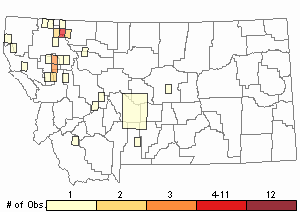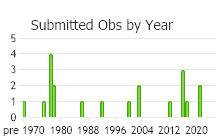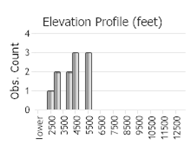View in other NatureServe Network Field Guides
NatureServe
Montana
Utah
Wyoming
Idaho
Wisconsin
British Columbia
South Carolina
Yukon
California
New York
Frizzled Crisp Moss - Tortella tortuosa
Other Names:
Double Twist Moss
General Description
Plants: Acrocarpous (Vitt 1988). Growing in crowded, upright clumps (Crum & Anderson et al. 1981); green or green with buttery tones above, brownish below; leaves lax, leaving some of the leaf bases visible, barely tufted with slightly crowded leaves at the top. Stems noticeably covered with long (FNA 2007), russet rhizoids, sometimes with a few short branches above; central strand absent (Flowers 1988).
Leaves: Strongly spiraled and retaining most of the leaf tips when dry, sometimes fragile, prominently wavy, upright or spreading somewhat (FNA 2007) and flexuose when moist, long, narrow, and lance-shaped, tapering to a long narrow point from a wider base, cupped (Lawton 1971), 4-6.5 mm in length; margins flat (Malcolm & Malcolm 2009); costa shiny, excurrent, merging with the lamina to form an apiculus (Crum & Anderson et al. 1981).
Leaf Cells: Laminal cells 1-layered; lower laminal cells hyaline and fine-walled, conspicuously distinct from the papillose upper laminal cells (FNA 2007), the sudden demarcation between them V-shaped (Malcolm & Malcolm 2009); upper laminal cells chlorophyllose, isodiametric, covered with C-shaped papillae on both sides; costa with epidermal cells, 1 row of guide cells, and dorsal and ventral stereid bands (FNA 2007).
Phenology
Fruit ripens the last part of spring and into the summer (through August) (FNA 2007).
Diagnostic Characteristics
The spiraling and contorted leaves, very wavy margins, and long glossy apiculus provide a combination of characteristics not found in other closely related species (FNA 2007).
Stunted plants may appear similar to T. fragilis, but T. fragilis has firmer and more upright leaves that are typically delicate (FNA 2007).
Trichostomum tenuirostre, which also has twisting and curly leaf apices, has clear basal cells that run along the leaf margins only a small distance rather than more considerably and forming the “V” as in Tortella tortuosa (Crum & Anderson et al. 1981).
Range Comments
North American Range
Canada: Known in all provinces and territories except MB and PE; USA: Found in most states in the northern 2/3, NM and TX; Mexico (FNA 2007). Known in Montana from Fergus, Flathead, Glacier, Lake, Lewis and Clark, Lincoln, Ravalli, and Valley Counties (Elliott 2016).
Observations in Montana Natural Heritage Program Database
Number of Observations: 42
(Click on the following maps and charts to see full sized version)
Map Help and Descriptions
Relative Density

Recency



 (Observations spanning multiple months or years are excluded from time charts)
(Observations spanning multiple months or years are excluded from time charts)
Habitat
Calcareous rock fissures, shelves, boulders in open or forest-canopied habitats, dry wooded slopes, or wetter habitats such as humus along riverbanks (FNA 2007) and peaty soil or decaying wood in Cedar swamps. Elevation: 330-12,470 feet (FNA 2007).
Reproductive Characteristics
Dioicous. Perigonial leaves not as long as vegetative leaves; interior perichaetial leaves not as contorted as vegetative leaves, light yellow (Lawton 1981). Seta 9-27 mm in length (seldom longer). Capsule 1.5-3.3 mm in length (Crum & Anderson et al. 1981), yellow to russet (Lawton 1971); peristome teeth filiform (FNA 2007), twisted (Lawton 1971), making 2-3 revolutions (Flowers 1988).
References
- Literature Cited AboveLegend:
 View Online Publication
View Online Publication Crum, H.A. and L.E. Anderson. 1981. Mosses of Eastern North America. 2 volumes. Columbia University Press, New York. 1328 pp.
Crum, H.A. and L.E. Anderson. 1981. Mosses of Eastern North America. 2 volumes. Columbia University Press, New York. 1328 pp. Elliott, J.C. and A.K. Pipp. 2018. A Checklist of Montana Mosses (1880-2018). Updated 3 January, 2020. Montana Natural Heritage Program, Helena, Montana. 73 pp.
Elliott, J.C. and A.K. Pipp. 2018. A Checklist of Montana Mosses (1880-2018). Updated 3 January, 2020. Montana Natural Heritage Program, Helena, Montana. 73 pp. Flora of North America Editorial Committee, eds. 2007. Flora of North America North of Mexico. Volume 27. Bryophytes: Mosses, Part 1. Oxford University Press, Inc., NY. xxi + 713 pp.
Flora of North America Editorial Committee, eds. 2007. Flora of North America North of Mexico. Volume 27. Bryophytes: Mosses, Part 1. Oxford University Press, Inc., NY. xxi + 713 pp. Flowers, S. 1973. Mosses: Utah and the West. Brigham Young University, Provo, Utah. 567 p.
Flowers, S. 1973. Mosses: Utah and the West. Brigham Young University, Provo, Utah. 567 p. Lawton, E. 1971. Keys for the Identification of the Mosses on the Pacific Northwest. Reprinted from 'Moss Flora of the Pacific Northwest'. Published as Supplement No. 2 of the Journal of the Hattori Botanical Laboratory. Nichinan, Miyazaki, Japan. 66 pp.
Lawton, E. 1971. Keys for the Identification of the Mosses on the Pacific Northwest. Reprinted from 'Moss Flora of the Pacific Northwest'. Published as Supplement No. 2 of the Journal of the Hattori Botanical Laboratory. Nichinan, Miyazaki, Japan. 66 pp. Malcolm, B., N. Malcolm, J. Shevock, and D. Norris. 2009. California Mosses. Nelson, New Zealand: Micro-Optics Press. 430 pp.
Malcolm, B., N. Malcolm, J. Shevock, and D. Norris. 2009. California Mosses. Nelson, New Zealand: Micro-Optics Press. 430 pp. Vitt, D. J. Marsh, and R. Bovey. 1988. Mosses, Lichens & Ferns of Northwest North America. Seattle, WA: University of Washington Press. 296 p.
Vitt, D. J. Marsh, and R. Bovey. 1988. Mosses, Lichens & Ferns of Northwest North America. Seattle, WA: University of Washington Press. 296 p.
- Additional ReferencesLegend:
 View Online Publication
View Online Publication
Do you know of a citation we're missing? Elliot, J. C. 1993. Second checklist of Montana mosses. Unpublished report. U.S. Forest Service, Region 1. Missoula, MT. 45 pp.
Elliot, J. C. 1993. Second checklist of Montana mosses. Unpublished report. U.S. Forest Service, Region 1. Missoula, MT. 45 pp. Lawton, E. 1971. Moss Flora of the Pacific Northwest. Hattori Botanical Laboratory. Japan: Yamabuki-cho, Shinjuku-ku, Tokyo. 362 pages plus appendices.
Lawton, E. 1971. Moss Flora of the Pacific Northwest. Hattori Botanical Laboratory. Japan: Yamabuki-cho, Shinjuku-ku, Tokyo. 362 pages plus appendices. Smith, A.J.E. 1980. The Moss Flora of Britain and Ireland. Cambridge University Press, Cambridge. 705 pp.
Smith, A.J.E. 1980. The Moss Flora of Britain and Ireland. Cambridge University Press, Cambridge. 705 pp.
- Web Search Engines for Articles on "Frizzled Crisp Moss"





